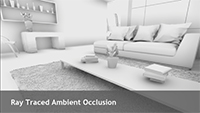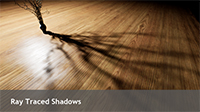Ray tracing simulates light, shadowing and other effects to near-perfection, which is why every film and big-budget TV show dedicates massive computational resources to each VFX shot, ensuring graphics blend seamlessly with reality. For over a decade NVIDIA has been at the forefront of this field, developing and accelerated rendering techniques, and assisting film studios with visual effects on the biggest blockbusters.
Now, we’re ready to deliver a generational leap in image quality in games, with NVIDIA RTX Technology. Powered by film-quality algorithms and new GameWorks SDK modules, RTX will enable developers to ray trace ambient occlusion effects, area shadows and glossy reflections in their games and engines. In other words, developers can create realistic, film-quality, physically-accurate scenes with lighting, shadows and reflections that capture the scene around them and account for every variable, immersing you in rich, detailed worlds that feature a level of fidelity you could previously only dream of.
It sounds like hyperbole, but we assure you it’s not. To prove that, NVIDIA RTX tech demos, powered by Volta-architecture GPUs, will be unveiled by 4A Games, Electronic Arts, Epic Games, Remedy Entertainment, and Unity this week at GDC 2018. Remedy Entertainment's demo is shown below, and as videos of the others are released we'll add them here also, so make sure to head back in a few days.
Remedy Entertainment’s NVIDIA RTX tech demo. Note: a ray-tracing denoiser module is coming to the GameWorks SDK, which will enable developers to remove film grain-like noise without any additional time-sapping development work
Screenshots from Remedy Entertainment's real-time ray tracing tech demo running on their Northlight engine, made possible by NVIDIA RTX Technology, Microsoft’s DXR API, and a Volta-architecture GPU
The Project PICA PICA tech demo from Electronic Arts' Search For Extraordinary Experiences Division
The stunning Reflections Star WarsTM tech demo from Epic Games
A collection of tech demos developed internally here at NVIDIA, highlighting how NVIDIA RTX real-time ray tracing can enhance graphical fidelity
The Metro Exodus NVIDIA RTX GDC 2018 demo from 4A Games
In the past we’ve demonstrated real-time ray tracing on many an occasion, but only in basic scenes, or at low framerates. Now, as the videos above show, NVIDIA RTX and the power of Volta-architecture GPUsmake real-time ray tracing a reality in highly detailed videogame scenes at playable framerates. And through a collaboration with Microsoft, RTX will be fully supported in applications that utilize their new DirectX® Raytracing (DXR) API, and Volta-architecture GPUs, ensuring widespread support for the new features.
Kim Libreri, chief technology officer at Epic Games, developer of the cutting-edge Unreal Engine, commented that, “the availability of NVIDIA RTX opens the door to make real-time ray tracing a reality.” And that, “by making such powerful technology available to the game development community with the support of the new DirectX Raytracing API, NVIDIA is the driving force behind the next generation of game and movie graphics.”
Over at Remedy Entertainment, the boundary-pushing studio responsible for Alan Wake, Max Payne and Quantum Break, technology team manager Mikko Orrenmaa stated that, “Integrating NVIDIA RTX into our Northlight engine was a relatively straightforward exercise,” adding, “we were surprised just how quickly we were able to prototype new lighting, reflection and ambient occlusion techniques, with significantly better visual fidelity than traditional rasterization techniques.” And like other studios, Remedy is, “really excited about what we can achieve in the future with the NVIDIA RTX technology; gamers are in for a something special.”
With the capabilities and tools of NVIDIA RTX, our ready-made ray tracing GameWorks SDK modules, and Microsoft’s DXR API, Epic, Remedy and every other developer out there can dramatically increase realism to a degree that was never before possible, and drastically shorten the time it takes to develop and integrate ray tracing effects.
If you’re a developer, head here to learn more about NVIDIA RTX. Or if you simply wish to learn more about ray tracing itself, check out our “What’s the Difference Between Ray Tracing and Rasterization?” primer. It’s techy, but by the end you’ll be a ray tracing expert!








Comentários
Postar um comentário